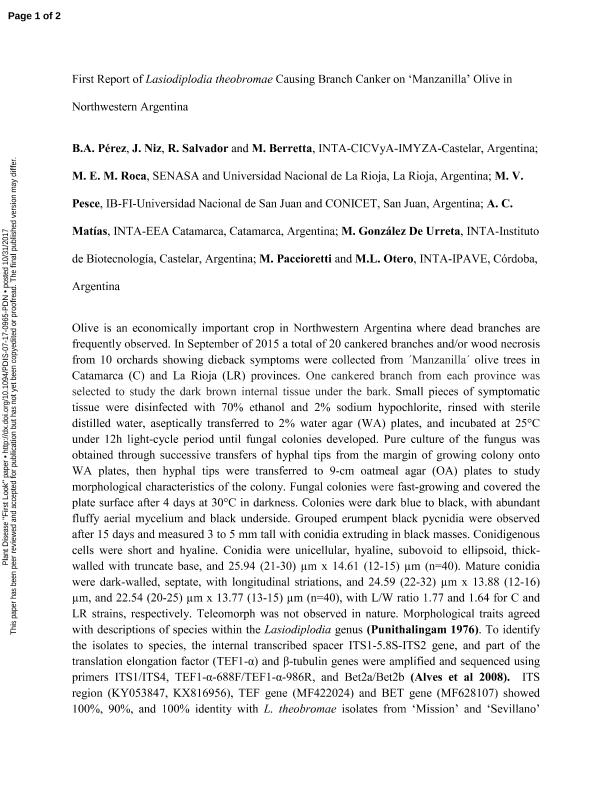Mostrar el registro sencillo del ítem
dc.contributor.author
Pérez, B.A.
dc.contributor.author
Niz, J.
dc.contributor.author
Salvador, R.
dc.contributor.author
Berretta, Marcelo Facundo

dc.contributor.author
Roca, Monica Esther María

dc.contributor.author
Pesce, Virginia Mercedes

dc.contributor.author
Matías, A.C.
dc.contributor.author
González de Urreta, Martín Salvador

dc.contributor.author
Paccioretti, Mauro Andrés

dc.contributor.author
Otero, M.L.
dc.date.available
2020-03-17T20:23:01Z
dc.date.issued
2018-03
dc.identifier.citation
Pérez, B.A.; Niz, J.; Salvador, R.; Berretta, Marcelo Facundo; Roca, Monica Esther María; et al.; First Report of Lasiodiplodia theobromae Causing Branch Canker on "Manzanilla" Olive in Northwestern Argentina; American Phytopathological Society; Plant Disease; 102; 3; 3-2018; 677-677
dc.identifier.issn
0191-2917
dc.identifier.uri
http://hdl.handle.net/11336/99923
dc.description.abstract
Olive is an economically important crop in Northwestern Argentina where dead branches are frequently observed. In September of 2015 a total of 20 cankered branches and/or wood necrosis from 10 orchards showing dieback symptoms were collected from ´Manzanilla´ olive trees in Catamarca (C) and La Rioja (LR) provinces. One cankered branch from each province was selected to study the dark brown internal tissue under the bark. Small pieces of symptomatic tissue were disinfected with 70% ethanol and 2% sodium hypochlorite, rinsed with sterile distilled water, aseptically transferred to 2% water agar (WA) plates, and incubated at 25°C under 12h light-cycle period until fungal colonies developed. Pure culture of the fungus was obtained through successive transfers of hyphal tips from the margin of growing colony onto WA plates, then hyphal tips were transferred to 9-cm oatmeal agar (OA) plates to study morphological characteristics of the colony. Fungal colonies were fast-growing and covered the plate surface after 4 days at 30°C in darkness. Colonies were dark blue to black, with abundant fluffy aerial mycelium and black underside. Grouped erumpent black pycnidia were observed after 15 days and measured 3 to 5 mm tall with conidia extruding in black masses. Conidigenous cells were short and hyaline. Conidia were unicellular, hyaline, subovoid to ellipsoid, thickwalled with truncate base, and 25.94 (21-30) μm x 14.61 (12-15) μm (n=40). Mature conidia were dark-walled, septate, with longitudinal striations, and 24.59 (22-32) μm x 13.88 (12-16) μm, and 22.54 (20-25) μm x 13.77 (13-15) μm (n=40), with L/W ratio 1.77 and 1.64 for C and LR strains, respectively. Teleomorph was not observed in nature. Morphological traits agreed with descriptions of species within the Lasiodiplodia genus (Punithalingam 1976). To identify the isolates to species, the internal transcribed spacer ITS1-5.8S-ITS2 gene, and part of the translation elongation factor (TEF1-α) and β-tubulin genes were amplified and sequenced using primers ITS1/ITS4, TEF1-α-688F/TEF1-α-986R, and Bet2a/Bet2b (Alves et al 2008). ITS region (KY053847, KX816956), TEF gene (MF422024) and BET gene (MF628107) showed 100%, 90%, and 100% identity with L. theobromae isolates from ?Mission? and ?Sevillano? (JX515716, JX515717), and ?Sevillano? (JX515763, JX515685) olives from California, respectively (Úrbez-Torres et al 2013). DNA sequences were deposited in GenBank. Two fungal isolates, one for each province, were used for pathogenicity tests. Isolates C and LR were grown on OA and incubated at 25°C under 12 h light for 7 days. Pathogenicity was verified on 10 healthy young ´Arbequina´ olive plants. Three small wounds were made on the stem of each plant with a sterile needle. Mycelial plugs were placed on the wounded surface, covered with wet cotton, and kept under 100% RH until symptom development. Non-colonized plugs were used as negative controls. Dark brown lesions were observed extending from the inoculation site reaching 3 cm after 30 days. Control plants showed no symptoms. Re-isolation of the fungus from diseased parts showed the same morphological traits than the fungus isolated from the field. This fungus was previously described on olive trees in Italy (Carlucci et al 2013), and California (Úrbez-Torres et al 2013). This is the first report of L. theobromae on olive in Argentina.
dc.format
application/pdf
dc.language.iso
eng
dc.publisher
American Phytopathological Society

dc.rights
info:eu-repo/semantics/openAccess
dc.rights.uri
https://creativecommons.org/licenses/by-nc-sa/2.5/ar/
dc.subject
LASIODIPLODIA
dc.subject
OLIVE
dc.subject.classification
Micología

dc.subject.classification
Ciencias Biológicas

dc.subject.classification
CIENCIAS NATURALES Y EXACTAS

dc.subject.classification
Agronomía, reproducción y protección de plantas

dc.subject.classification
Agricultura, Silvicultura y Pesca

dc.subject.classification
CIENCIAS AGRÍCOLAS

dc.title
First Report of Lasiodiplodia theobromae Causing Branch Canker on "Manzanilla" Olive in Northwestern Argentina
dc.type
info:eu-repo/semantics/article
dc.type
info:ar-repo/semantics/artículo
dc.type
info:eu-repo/semantics/publishedVersion
dc.date.updated
2020-02-26T14:58:51Z
dc.identifier.eissn
1943-7692
dc.journal.volume
102
dc.journal.number
3
dc.journal.pagination
677-677
dc.journal.pais
Estados Unidos

dc.journal.ciudad
St. Paul
dc.description.fil
Fil: Pérez, B.A.. Instituto Nacional de Tecnología Agropecuaria. Centro de Investigación en Ciencias Veterinarias y Agronómicas. Instituto de Microbiología y Zoología Agrícola; Argentina
dc.description.fil
Fil: Niz, J.. Instituto Nacional de Tecnología Agropecuaria. Centro de Investigación en Ciencias Veterinarias y Agronómicas. Instituto de Microbiología y Zoología Agrícola; Argentina
dc.description.fil
Fil: Salvador, R.. Instituto Nacional de Tecnología Agropecuaria. Centro de Investigación en Ciencias Veterinarias y Agronómicas. Instituto de Microbiología y Zoología Agrícola; Argentina
dc.description.fil
Fil: Berretta, Marcelo Facundo. Consejo Nacional de Investigaciones Científicas y Técnicas; Argentina. Instituto Nacional de Tecnología Agropecuaria. Centro de Investigación en Ciencias Veterinarias y Agronómicas. Instituto de Microbiología y Zoología Agrícola; Argentina
dc.description.fil
Fil: Roca, Monica Esther María. Universidad Nacional de La Rioja; Argentina. Ministerio de Agricultura, Ganadería, Pesca y Alimento. Servicio Nacional de Sanidad y Calidad Agroalimentaria; Argentina
dc.description.fil
Fil: Pesce, Virginia Mercedes. Consejo Nacional de Investigaciones Científicas y Técnicas. Centro Científico Tecnológico Conicet - San Juan; Argentina. Universidad Nacional de San Juan. Facultad de Ingeniería; Argentina
dc.description.fil
Fil: Matías, A.C.. Instituto Nacional de Tecnología Agropecuaria. Centro Regional Catamarca-La Rioja. Estación Experimental Agropecuaria Catamarca; Argentina
dc.description.fil
Fil: González de Urreta, Martín Salvador. Consejo Nacional de Investigaciones Científicas y Técnicas; Argentina. Instituto Nacional de Tecnología Agropecuaria. Centro de Investigación en Ciencias Veterinarias y Agronómicas. Instituto de Biotecnología; Argentina
dc.description.fil
Fil: Paccioretti, Mauro Andrés. Instituto Nacional de Tecnología Agropecuaria. Centro de Investigaciones Agropecuarias. Instituto de Patología Vegetal; Argentina
dc.description.fil
Fil: Otero, M.L.. Instituto Nacional de Tecnología Agropecuaria. Centro de Investigaciones Agropecuarias. Instituto de Patología Vegetal; Argentina
dc.journal.title
Plant Disease

dc.relation.alternativeid
info:eu-repo/semantics/altIdentifier/url/https://apsjournals.apsnet.org/toc/pdis/102/3
dc.relation.alternativeid
info:eu-repo/semantics/altIdentifier/doi/https://doi.org/10.1094/PDIS-07-17-0965-PDN
Archivos asociados
